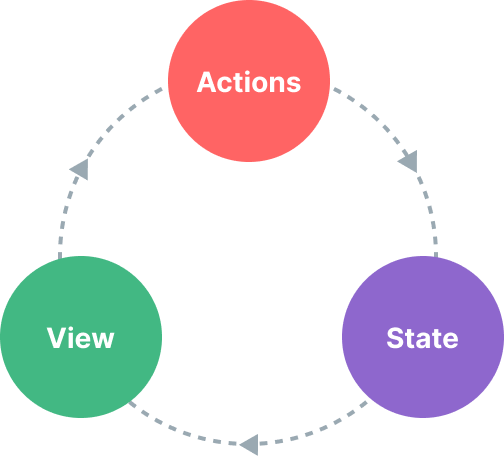State Management
What is State Management?
Technically, every Kdu component instance already "manages" its own reactive state. Take a simple counter component as an example:
<script setup>
import { ref } from 'kdu'
// state
const count = ref(0)
// actions
function increment() {
count.value++
}
</script>
<!-- view -->
<template>{{ count }}</template>
It is a self-contained unit with the following parts:
- The state, the source of truth that drives our app;
- The view, a declarative mapping of the state;
- The actions, the possible ways the state could change in reaction to user inputs from the view.
This is a simple representation of the concept of "one-way data flow":

However, the simplicity starts to break down when we have multiple components that share a common state:
- Multiple views may depend on the same piece of state.
- Actions from different views may need to mutate the same piece of state.
For case one, a possible workaround is by "lifting" the shared state up to a common ancestor component, and then pass it down as props. However, this quickly gets tedious in component trees with deep hierarchies, leading to another problem known as Prop Drilling.
For case two, we often find ourselves resorting to solutions such as reaching for direct parent / child instances via template refs, or trying to mutate and synchronize multiple copies of the state via emitted events. Both of these patterns are brittle and quickly lead to unmaintainable code.
A simpler and more straightforward solution is to extract the shared state out of the components, and manage it in a global singleton. With this, our component tree becomes a big "view", and any component can access the state or trigger actions, no matter where they are in the tree!
Simple State Management with Reactivity API
If you have a piece of state that should be shared by multiple instances, you can use reactive() to create a reactive object, and then import it from multiple components:
// store.js
import { reactive } from 'kdu'
export const store = reactive({
count: 0
})
<!-- ComponentA.kdu -->
<script setup>
import { store } from './store.js'
</script>
<template>From A: {{ store.count }}</template>
<!-- ComponentB.kdu -->
<script setup>
import { store } from './store.js'
</script>
<template>From B: {{ store.count }}</template>
Now whenever the store object is mutated, both <ComponentA> and <ComponentB> will update their views automatically - we have a single source of truth now.
However, this also means any component importing store can mutate it however they want:
<template>
<button @click="store.count++">
From B: {{ store.count }}
</button>
</template>
While this works in simple cases, global state that can be arbitrarily mutated by any component is not going to be very maintainable in the long run. To ensure the state-mutating logic is centralized like the state itself, it is recommended to define methods on the store with names that express the intention of the actions:
// store.js
import { reactive } from 'kdu'
export const store = reactive({
count: 0,
increment() {
this.count++
}
})
<template>
<button @click="store.increment()">
From B: {{ store.count }}
</button>
</template>
TIP
Note the click handler uses store.increment() with the parenthesis - this is necessary to call the method with the proper this context since it's not a component method.
Although here we are using a single reactive object as a store, you can also share reactive state created using other Reactivity APIs such as ref() or computed(), or even return global state from a Composable:
import { ref } from 'kdu'
// global state, created in module scope
const globalCount = ref(1)
export function useCount() {
// local state, created per-component
const localCount = ref(1)
return {
globalCount,
localCount
}
}
The fact that Kdu's reactivity system is decoupled from the component model makes it extremely flexible.
SSR Considerations
If you are building an application that leverages Server-Side Rendering (SSR), the above pattern can lead to issues due to the store being a singleton shared across multiple requests. This is discussed in more details in the SSR guide.